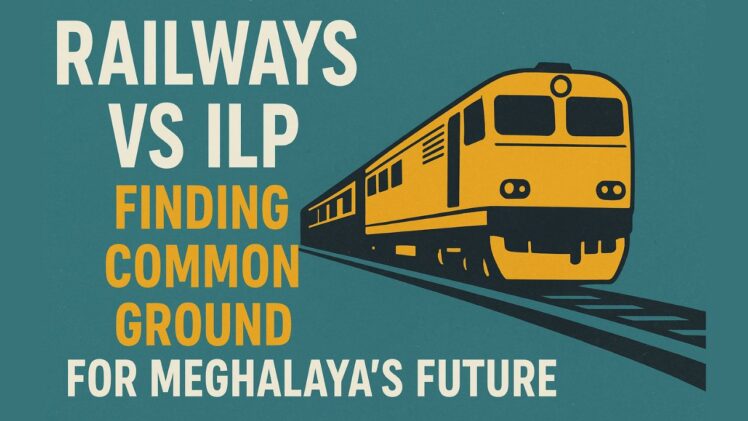
By Toki Blah
The Rynsan Iathir || Jingmyntoi & Jingduhnong ka Lynti Rel (The Rynsan Iathir || Pros and Cons of Railways) published on April 5, 2025 hosted by Kong Ibankyntiew Mawrie on behalf of 4Front Media Channel on the need for an All-Party meet to discuss the Meg railhead and subsequently participated by four political representatives of the state, was interesting to watch. I would like to give my comments, for whatever it is worth, on the same with the hope that it may be of help to resolve this contentious issue of Railways vs ILP (Inner Line Permit).
General Observation.
It’s obvious that the introduction of railways into all states of the NE is the Centre’s desire to improve connectivity of the region with the rest of the country. This will also improve and speed up the development of this region. The recent developments in Bangladesh has made this all the more important and I think New Delhi is deeply concerned with the security threats now emerging from our Southern neighbour. To my mind it will push for more improved connectivity and is not likely to tolerate any opposition on issues involving National Security.
On the other hand, for the indigenous people of Meghalaya, with their miniscule population, the threat of being overwhelmed or simply swamped over by outsiders is of equal importance. Their demand for an effective mechanism to control influx of outsiders into the state is justified and needs to be understood by Delhi. Hence the demand for the ILP which New Delhi, in the name of National integration and of freedom of Indian citizens to move freely within their own country (Art 19.1.d of the Constitution), is unwilling to give.
Therein lies the problem which we have to solve. To be able to do this, I believe we shall have to offer New Delhi a control mechanism, that is acceptable to both Centre and State by addressing the concerns of both as mentioned above.
Issues that emerged from the Panel discussion
- Everyone endorsed the opinion that if influx into Meghalaya remained unchecked there was that genuine fear of the emergence of a demographic imbalance unfavourable to the indigenous communities of Meghalaya. No one wanted this to happen and there was clear unanimity on this issue.
- It was encouraging, however, to note that for the first time the problem of influx (usually termed as ka jingrung kyrthep u mynder) was this time correctly defined as (ka jinglah buhai shnong) u nongwei. Thus, the issue of fear over unchecked “entry of outsiders” into the state, changed into the fear relating to the threat of “our inability to prevent outsider settlement” within Meghalaya. We must understand that unlike other Dead End NE states, (Nagaland, Arunachal, Manipur and Mizoram) Meghalaya is a transit state and thus entry into it will be difficult to control. Implementing a control mechanism like the ILP well nigh impossible. Hence Delhi’s reluctance to cede to the ILP demand and this is not likely to change.
- Preventing outsider settlement in this sensitive border Tribal state, however, is a totally different matter which, to my mind, New Delhi, is likely to understand and appreciate. Depending on how we present our case, “reasonable restrictions” provided for in Art 19 (5) might actually work in our favour. For the first time the narrative has changed! From “entry of outsiders” to “unchecked ability of outsiders to settle and cause a demographic imbalance in this Tribal state” are two different problems demanding two entirely different solutions. This is important to understand and may well lead to coming up with an effective answer to the vexed issue of Influx.
- It was also encouraging to note that no political party was opposed to the development of the state. In fact, everyone wanted it but at the same time, every party wanted to retain its voter base by endorsing the Pressure Group demand for the ILP before any discussion on the railhead could be carried out. The Panel Discussion in this aspect, therefore, turned out to be a paradox of contradictions. “Discretion is the better part of valour” seems to be the general consensus of almost all the panelists except for the BJP representative. He cautioned we might live to regret our political inability to call the bluff of the Pressure Groups, but his warning was ignored by the others. I found this quite amusing, as protecting vote bank politics over rode simple common sense and the state’s interest. But that is Indian Politics for you, so really no surprise.
- Everyone spoke of the need for an influx control mechanism. Now apparently because of a wrong perception of the problem, as pointed out above, we have only two options before us i.e. the ILP and the MRSSA (Meghalaya Residents’ Safety and Security Act). Woefully, it seems the former is not acceptable to the Centre while the MRSSA still needs fine tuning to make it functional as per the needs of the hour.
ALSO WATCH FULL DISCUSSION ON RAILWAYS IN KHASI
Conclusion
These conclusions are mine and mine alone based on what I saw and heard from the panel discussion mentioned above.
- An all-party meeting at this point of time is unlikely to happen seeing the reluctance of some prominent parties to participate.
- Now in view of the eviction drive in Assam, the spill over this time can well happen through the porous Assam –Meghalaya border and not through regulated routes like motorable roads etc, where the ILP implementation will be easy. This time the infiltration will likely be through thick forested areas located in remote rural villages of Meghalaya and difficult to detect. What do we do then?
- Apparently, we have to go back to the drawing board and work out an effective plan of action where both the development of the state and this new perception on Influx can exist together. The new perception on influx, if agreed upon, can be a good entry point for coming up with a new plan and for an All-Party Meet on the same.
- To me, the best method to protect the interest of genuine residents of Meghalaya would lie in the creation of digitally based biometric ID cards for everyone, but perhaps that’s another story for another day.
- Before us today is the unresolved problem of unregulated influx. We have identified “ka jinglah buhai shnong suk u barjylla” as the focal point of influx and not “jingrung kyrthep u mynder” as previously believed. Once this is accepted then the whole paradigm as to who is best equipped to control influx also changes. We can’t depend on the Police. They just don’t have the reach nor the manpower. Then again, since all Meghalayans are concerned over influx; since you and me together are main stakeholders to the issue, why shouldn’t we also be included and involved in checking influx? We can easily do this through our respective Dorbars, for both Rural as well as Urban areas. If this makes sense then the involvement of the public, and not only a few police personnel, must be encouraged to check influx. After all participation of the common man will bring in sustainability to anything we do.
- The best mechanism we have with us today for such a thing to happen is the MRSSA. It, however, requires to be tweaked a bit to make it more effective.
- Last but not least, we speak here of the interest of the people of Meghalaya and what is best for Meghalaya. In such scenarios, it’s best that Egos, whoever big they might be, should be kept in the background. Its People first. Egos last!
(Toki Blah is a retired Indian Administrative Service (IAS) officer; he frequently writes columns for local newspapers in Meghalaya and offers consultancy on development matters.)
The opinions expressed in this publication are those of the author. They do not purport to reflect the opinions or views of 4Front Media or its members.






